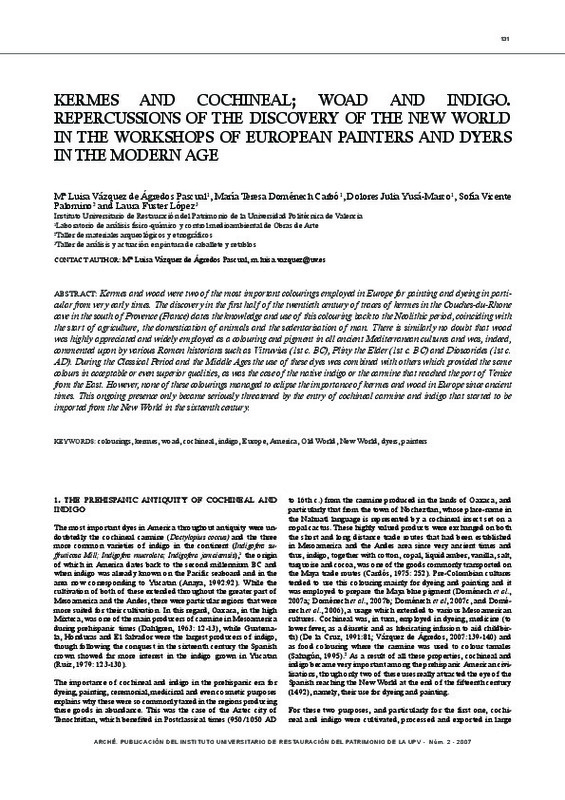JavaScript is disabled for your browser. Some features of this site may not work without it.
Buscar en RiuNet
Listar
Mi cuenta
Estadísticas
Ayuda RiuNet
Admin. UPV
Kermes and cochineal; woad and indigo. Repercussions of the discovery of the new world in the workshops of european painters and dyers in the modern age
Mostrar el registro sencillo del ítem
Ficheros en el ítem
| dc.contributor.author | Vázquez de Agredos Pascual, María Luisa
|
es_ES |
| dc.contributor.author | Domenech Carbo, Mª Teresa
|
es_ES |
| dc.contributor.author | Yusa Marco, Dolores Julia
|
es_ES |
| dc.contributor.author | Vicente Palomino, Sofía
|
es_ES |
| dc.contributor.author | Fuster López, Laura
|
es_ES |
| dc.date.accessioned | 2013-09-20T12:34:19Z | |
| dc.date.available | 2013-09-20T12:34:19Z | |
| dc.date.issued | 2007 | |
| dc.identifier.issn | 1887-3960 | |
| dc.identifier.uri | http://hdl.handle.net/10251/32256 | |
| dc.description.abstract | Kermes and woad were two of the most important colourings employed in Europe for painting and dyeing in particular from very early times. The discovery in the first half of the twentieth century of traces of kermes in the Couches-du-Rhone cave in the south of Provence (France) dates the knowledge and use of this colouring back to the Neolithic period, coinciding with the start of agriculture, the domestication of animals and the sedentarisation of man. There is similarly no doubt that woad was highly appreciated and widely employed as a colouring and pigment in all ancient Mediterranean cultures and was, indeed, commented upon by various Roman historians such as Vitruvius (1st c. BC), Pliny the Elder (1st c. BC) and Dioscorides (1st c. AD). During the Classical Period and the Middle Ages the use of these dyes was combined with others which provided the same colours in acceptable or even superior qualities, as was the case of the native indigo or the carmine that reached the port of Venice from the East. However, none of these colourings managed to eclipse the importance of kermes and woad in Europe since ancient times. This ongoing presence only became seriously threatened by the entry of cochineal carmine and indigo that started to be imported from the New World in the sixteenth century. | es_ES |
| dc.description.abstract | El kermes y el pastel fueron dos de los colorantes más importantes que se utilizaron en Europa desde tiempos muy antiguos para el teñido y la pintura, en especial para el primero de ellos. El descubrimiento que se hizo en la primera mitad del siglo XX de restos de kermes en la cueva de Bouches-du-Rhone, al sur de la región de la Provenza (Francia), remontan su conocimiento y uso al Neolítico, coincidiendo con el inicio de la agricultura, de la domesticación de animales y de la sedentarización del hombre. Por su parte, no hay duda de que el pastel fue altamente valorado y utilizado como colorante y pigmento en todas las culturas del Mediterráneo antiguo, siendo varios los historiadores romanos que lo describieron en sus obras, entre ellos Vitrubio (s. I a.C), Plinio el Viejo (s. I d.C) y Dioscórides (s. I d.C). Durante la Antigüedad y la Edad Media el uso de estos tintes se combinó con otros que aportaron sus mismos colores en calidades aceptables e incluso superiores, tales como el índigo nativo o la grana que llegaba al puerto de Venecia desde Oriente. Sin embargo, ninguno de estos colorantes consiguieron eclipsar la importancia que desde antiguo tuvieron el kermes y el pastel en Europa, que sólo se vieron realmente amenazados con la entrada de la grana cochinilla y del índigo que en el siglo XVI comenzaron a importarse desde el Nuevo Mundo. | es_ES |
| dc.format.extent | 6 | es_ES |
| dc.language | Inglés | es_ES |
| dc.publisher | Instituto Universitario de Restauración del Patrimonio de la UPV | es_ES |
| dc.relation.ispartof | Arché | es_ES |
| dc.rights | Reserva de todos los derechos | es_ES |
| dc.subject.classification | CONSERVACION Y RESTAURACION DE BIENES CULTURALES (UPV) | es_ES |
| dc.title | Kermes and cochineal; woad and indigo. Repercussions of the discovery of the new world in the workshops of european painters and dyers in the modern age | es_ES |
| dc.title.alternative | Kermes y cochinilla, añil e indigo. Repercusiones del descubrimiento del nuevo mundo en los talleres de los pintores y tintoreros europeos en la edad moderna | es_ES |
| dc.type | Artículo | es_ES |
| dc.rights.accessRights | Abierto | es_ES |
| dc.contributor.affiliation | Universitat Politècnica de València. Instituto Universitario de Restauración del Patrimonio - Institut Universitari de Restauració del Patrimoni | es_ES |
| dc.description.bibliographicCitation | Vázquez De Agredos Pascual, ML.; Domenech Carbo, MT.; Yusa Marco, DJ.; Vicente Palomino, S.; Fuster López, L. (2007). Kermes and cochineal; woad and indigo. Repercussions of the discovery of the new world in the workshops of european painters and dyers in the modern age. Arché. (2):131-136. http://hdl.handle.net/10251/32256 | es_ES |
| dc.description.upvformatpinicio | 131 | es_ES |
| dc.description.upvformatpfin | 136 | es_ES |
| dc.description.issue | 2 | es_ES |
| dc.identifier.eissn | 2445-1150 |
Este ítem aparece en la(s) siguiente(s) colección(ones)
-
Arché - Nº 02 : 2007 [27]






